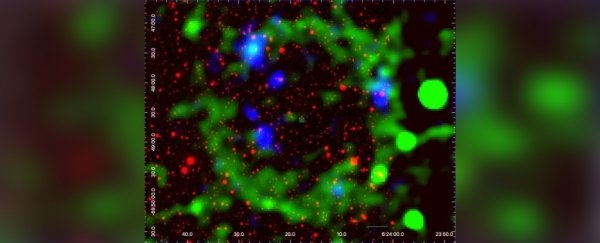The Universe isn't a chaotic free-for-all. Most of the stars are bound up in galaxies, which are separated by vast, almost unimaginable distances.
The space between the galaxies – intergalactic space – is sparsely populated, but not entirely empty; there, too, occasional lone stars can also be found.
For the first time, astronomers think they have found evidence of the death of one of these lone rogue stars. Not far from the Large Magellanic Cloud, a satellite galaxy orbiting with the Milky Way, a mysterious and remarkably neat circle emanating radio waves has been detected, hanging in space, and called J0624–6948.
If it sounds familiar, there's a reason for that. Recently, astronomers have been baffled by several mysterious, radio-emitting space circles, named Odd Radio Circles, or ORCs.
The similarity wasn't lost on astronomer Miroslav Filipovic from the University of Western Sydney in Australia.
"When we originally discovered this almost perfectly circular radio object we thought it was yet another ORC," he says. "But after our additional observations, it became clear that this object is much more likely to be something else."
ORCs were first discovered using one of the world's most powerful radio telescopes, the Australian Square Kilometre Array Pathfinder (ASKAP) in Australia. These objects seemed to be huge, and distant, with several defining characteristics, not least of which is a galaxy in the dead center.
Scientists now think the ORCs are a result of an energetic process in those central galaxies, although the precise nature of that process is unknown.
In fact, it's probable that ORCs are actually spheres. The reason that they appear as rings is because of perspective; around the edges, there is a greater density of emission along our line of sight.
 The location of J0624–6948. (Filipovic et al., MNRAS, 2022)
The location of J0624–6948. (Filipovic et al., MNRAS, 2022)
Yet there are a few key differences between J0624–6948 and ORCs. The lack of an obvious central galaxy in J0624–6948 is a big one, but not decisive on its own. The spectral index of the radio emission is flatter than that of ORCs, and the apparent size of J0624–6948 is different, too – larger than the other ORCs.
Filipovic and his team considered a range of possibilities that might result in an object that resembles their observations. These included a much larger ORC, as well as a super-flare originating in a star near the galactic center, or jets from a distant active supermassive black hole.
In the end, one scenario stood out as the most consistent with the observed phenomenon.
"The most plausible explanation is that the object is an intergalactic Supernova Remnant due to an exploded star that resided in the Large Magellanic Cloud outskirts that had undergone a single-degenerate type Ia supernova which involves the explosion of two stars orbiting each other," Filipovic explains.
"What we've potentially then discovered is a unique remnant of [a] supernova that has expanded into a rarefied, intergalactic environment – an environment that we didn't expect to find in such an object. Our estimates point to the age of about 2,200 to 7,100 years old."
While supernova remnants don't tend to be so beautifully circular, it wouldn't be unprecedented. A handful of similar examples, like the stunning eye-shaped object SN 1987A in the Large Magellenic Cloud, have been documented.
If the scientists are right, J0624–6948 would be the first intergalactic supernova remnant ever identified – a bubble-like sphere of ejecta expanding outwards. According to the team's measurements, an association with the Large Magellanic Cloud would make J0624–6948 around 155 light-years across.
Follow-up observations could help resolve the uncertainties. In addition, more observations with instruments such as ASKAP and its South African counterpart MeerKAT could help identify more peculiar radio circles in the sky.
Finding more will give us a more complete picture of their range and diversity, which gives us a better chance of figuring out what they are.
"These new radio telescopes can pick up a range of spherical objects," Filipovic says. "Due to the combined effects of high-sensitivity, good spatial sampling, and wide area coverage, they are enriching our understanding of the Universe."
The research has been published in the Monthly Notices of the Royal Astronomical Society.
